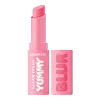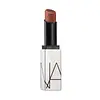What's inside
What's inside
 Key Ingredients
Key Ingredients

 Benefits
Benefits

 Concerns
Concerns

 Ingredients Side-by-side
Ingredients Side-by-side

Dimethicone
EmollientC12-15 Alkyl Benzoate
AntimicrobialOctyldodecanol
EmollientSilica
AbrasiveSynthetic Wax
AbrasiveMica
Cosmetic ColorantHydrogenated Polyisobutene
EmollientCandelilla Cera
EmollientPolysilicone-11
Squalane
EmollientDimethicone/Vinyl Dimethicone Crosspolymer
Skin ConditioningPolyphenylsilsesquioxane
Punica Granatum Sterols
Skin ConditioningVitis Vinifera Seed Oil
EmollientSqualene
EmollientCaprylyl Glycol
EmollientParfum
MaskingCocos Nucifera Oil
MaskingMedicago Sativa Extract
TonicStevia Rebaudiana Leaf/Stem Extract
MaskingCI 45410
Cosmetic ColorantCI 15850
Cosmetic ColorantDimethicone, C12-15 Alkyl Benzoate, Octyldodecanol, Silica, Synthetic Wax, Mica, Hydrogenated Polyisobutene, Candelilla Cera, Polysilicone-11, Squalane, Dimethicone/Vinyl Dimethicone Crosspolymer, Polyphenylsilsesquioxane, Punica Granatum Sterols, Vitis Vinifera Seed Oil, Squalene, Caprylyl Glycol, Parfum, Cocos Nucifera Oil, Medicago Sativa Extract, Stevia Rebaudiana Leaf/Stem Extract, CI 45410, CI 15850
Pentaerythrityl Tetraisostearate
EmollientC12-15 Alkyl Benzoate
AntimicrobialOctyldodecanol
EmollientPolyethylene
AbrasiveMica
Cosmetic ColorantSilica
AbrasiveLauroyl Lysine
Skin ConditioningBambusa Arundinacea Stem Powder
AbrasiveTriacontanyl Pvp
HumectantDicalcium Phosphate
AbrasiveSilica Silylate
EmollientSynthetic Wax
AbrasiveHydrogenated Olive Oil
Skin ConditioningOlea Europaea Fruit Oil
MaskingOlea Europaea Oil Unsaponifiables
Skin ConditioningTocopheryl Acetate
AntioxidantDisteardimonium Hectorite
StabilisingPentaerythrityl Tetra-Di-T-Butyl Hydroxyhydrocinnamate
AntioxidantEthyl Vanillin
MaskingPentaerythrityl Tetraisostearate, C12-15 Alkyl Benzoate, Octyldodecanol, Polyethylene, Mica, Silica, Lauroyl Lysine, Bambusa Arundinacea Stem Powder, Triacontanyl Pvp, Dicalcium Phosphate, Silica Silylate, Synthetic Wax, Hydrogenated Olive Oil, Olea Europaea Fruit Oil, Olea Europaea Oil Unsaponifiables, Tocopheryl Acetate, Disteardimonium Hectorite, Pentaerythrityl Tetra-Di-T-Butyl Hydroxyhydrocinnamate, Ethyl Vanillin
Ingredients Explained
These ingredients are found in both products.
Ingredients higher up in an ingredient list are typically present in a larger amount.
C12-15 Alkyl Benzoate is made up of Benzoic Acid and long chain alcohols. It has a low molecular weight.
C12-15 Alkyl Benzoate is an emollient and texture enhancer. Due to its solubility, it is often used in sunscreens to help evenly distribute active ingredients.
As an emollient, C12-15 Alkyl Benzoate helps soften and hydrate your skin. Emollients create a film on your skin that traps moisture within.
This ingredient has been reported to cause eye irritation.
Learn more about C12-15 Alkyl BenzoateMica is a naturally occurring mineral used to add shimmer and color in cosmetics. It can also help improve the texture of a product or give it an opaque, white/silver color.
Serecite is the name for very fine but ragged grains of mica.
This ingredient is often coated with metal oxides like titanium dioxide. Trace amounts of heavy metals may be found in mica, but these metals are not harmful in our personal products.
Mica has been used since prehistoric times throughout the world. Ancient Egyptian, Indian, Greek, Roman, Aztec, and Chinese civilizations have used mica.
Learn more about MicaOctyldodecanol is a fatty alcohol. It is primarily used to enhance the texture of products.
As an emulsifier, Octyldodecanol helps prevent the oils and waters from separating. It also prevents ingredients from creating foam when shaken.
Octyldodecanol is created by reducing fatty acid to an alcohol.
Due to its high molecular weight, it does not get absorbed into the skin.
Learn more about OctyldodecanolSilica, also known as silicon dioxide, is a naturally occurring mineral. It is used as a fine, spherical, and porous powder in cosmetics.
Though it has exfoliant properties, the function of silica varies depending on the product.
The unique structure of silica enhances the spreadability and adds smoothness, making it a great texture enhancer.
It is also used as an active carrier, emulsifier, and mattifier due to its ability to absorb excess oil.
In some products, tiny microneedles called spicules are made from silica or hydrolyzed sponge. When you rub them in, they lightly polish away dead skin layers and enhance the penetration of active ingredients.
Learn more about SilicaSynthetic Wax is created from fossil fuels such as natural gas. It is used to enhance texture, adjust pH, and as an occlusive.
It may also be used as an abrasive ingredient to exfoliate the skin.
Synthetic Wax may not be fungal acne safe.
Learn more about Synthetic Wax